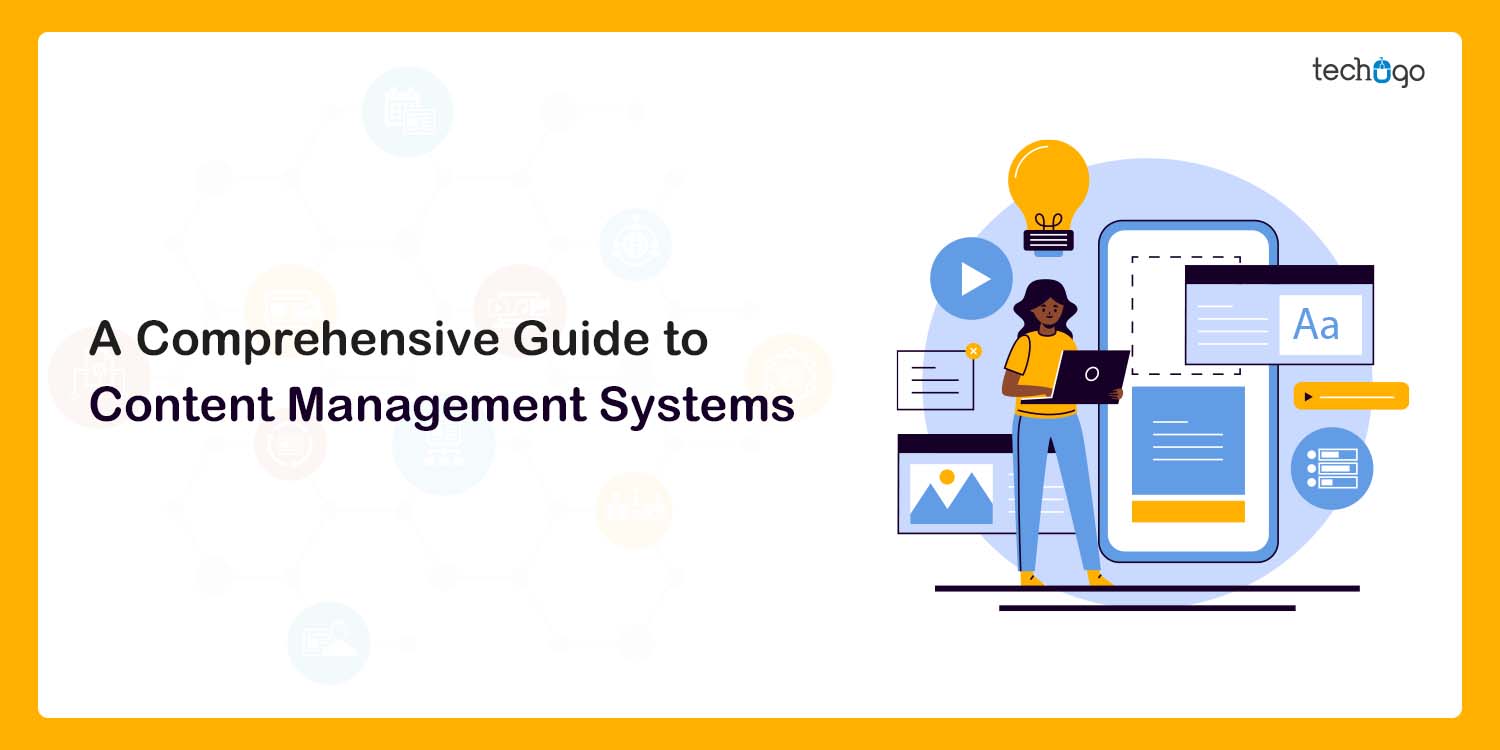5 Jan 2023
Updated on January 10th, 2023
A Comprehensive Guide to Content Management Systems
Surbhi Bhatia

A Content Management System (CMS) was an older software platform that aimed to automate tasks such as uploading content, formatting it to a webpage, and backstage tasks such as improving SEO.
Over the past few decades, however, digital content and assets have exploded in quantity and quality. New channels, interfaces, and devices have also made it easier to access them. Today, content is delivered to all devices: smartphones, TVs, and watches to voice-activated devices.
The definition of a Content Management System (CMS) has changed due to the rapidly growing digital ecosystem. As a result, many businesses are now reviewing their CMS options.
What’s a Content Management System (CMS)?
A content management system (or CMS) is a computer software program that organizes, manages, and publishes digital content such as documents and images. It can also be used to create, modify, and publish them in a collaborative environment for presentation on a website. You may also call it “web content management” or “digital platform” (DXP).
You have probably encountered a CMS in some form or another if you have worked with websites in any way over the past 20 years. It is used by the editorial staff of online newspapers, corporate digital marketing teams, and departments of governmental agencies. CMS is used by everyone, even small businesses, and bloggers. They don’t manually edit HTML files or upload them to the internet. Instead, they use a system that handles this and other tasks in a dynamic environment.
Bloggers about fashion, cooking, and other topics don’t have to worry about the technical or organizational aspects of managing a website. Instead, the CMS handles a lot of the heavy lifting, whether on its site or as a platform for blogging. The CMS automates and creates templates for technical IT stuff such as bloggers and marketers don’t need to worry.
What Are Different Types Of Content Management Systems?
The content management system (CMS), the market has seen significant growth over the past twenty years and is now mainstream. A study found that 95% of global organizations already have a CMS solution. The following sections will list the different content management systems available today.
1. Web Content Management System (WCMS)
Web content management software (WCMS), is a software content management system (CMS). It controls the content, mainly HTML content, that is consumed via multiple digital channels. It’s used to control and manage a large, dynamic web collection.
There are three types of web content management systems: open-source CMS, custom CMS, and commercial CMS.
– Open-Source Content Management System
Open-source software (CMS) can be downloaded at no cost. There are no licensing fees or upgrades. When integration with enterprise systems is not required, open-source CMS is the best choice. The following are some of the most popular open-source CMS platforms for digital transformation:
- WordPress
- Drupal
- Joomla
– Commercial Content Management System
A single company manages the commercial content management software as an admin user. You will need to pay a license fee in order to use the CMS software. Commercial CMS software is usually pre-built to meet your business’s needs. It is also easier to implement than open-source CMS. The following are some of the most popular commercial CMS platforms:
- Kentico
- Sitecore
- Adobe Experience Manager (AEM).
– Custom Content Management System
A custom content management system can be branded to meet your business’s specific needs. A new CMS, for example, is built on top of an open-source content management system. This bridges the gap between an open-source CMS and a commercial CMS.
2. Digital Asset Management System (DAM)
Digital assets are the basis of customer’s digital experiences. Therefore, access to digital assets must be available quickly, accurately, and securely for every organization. This allows distributed teams to locate the right asset and deliver the best customer experience via the appropriate channel.
However, without the ability to access, manage, organize, harness, and modify content from one source, the experience will be broken. Digital asset management systems (DAMs) are used to consolidate assets, content, workflows, and operations across multiple business units, departments, and teams.
3. Enterprise Content Management System (ECM)
Enterprise content management systems (ECM) are one type of content management system. They help to collect, store and deliver unstructured data such as email, office documents, reports, or scanned documents. It allows the organization to deliver the correct content to the intended audiences (e.g. employees, and business stakeholders).
Enterprise content management systems make it easy for all stakeholders within an organization to access the content. This allows them to make informed decisions and finish projects on time. ECM archives are also available after a specified retention period to ensure no unneeded content.
4. Component Content Management System (CCMS)
A component Content Management System is a typical content management system that organizes content at a component/granular scale. CCMS allows organizations to track, manage and store content as components, words, paragraphs, or phrases. This is in contrast to CMS’ page-by-page content management.
The CCMS is a great choice for media publishing companies publishing content on multiple platforms such as mobile, print, and pdf.
How to Use a CMS to Create a Website?
Let’s look at how a CMS can be used to create and manage a website. Although it may initially seem complicated, this solution’s main selling point is its simplicity. Most CMS platforms are easy to use, and you don’t need to be an expert in coding or have any previous experience building sites.
You can think of creating a website as building a house. The CMS is the foundation of the website. It includes the basic elements, such as the walls and roof, doors, plumbing, and plumbing. The CMS ensures that the foundation is set so you can concentrate on furnishing the space, decorating it, and making it liveable. This means you can fill your site with content and make it easier to use and work with.
WordPress is known for its core functionality. However, you can add plugins to your CMS or create your code.
Although every CMS is unique, there are common features. These include:
- Flexibility and extensibility. The CMS provides the foundations. You can then add new functionality to make your site unique and dynamic.
- Permission control. To ensure security, you need to assign users roles so that everyone has access to the content and functionality they need to perform their job (and nothing more).
- Multilingual support. Your site should not be limited to one language. Many CMS platforms can be used in multiple languages and are easily translated.
- Scalability. Sites tend to grow in terms of how many visitors they get and the content they contain. A CMS is designed to scale with your site’s requirements.
- Open API. An open Application Programming Interface makes it possible for you to access your site from other tools that are not connected. This allows you to manage your content and avoid the site’s default interface.
A CMS isn’t the only way to create a website. You could still create a site from scratch if you are skilled enough. However, a website builder might be a better option for you.
What do Different Content Management Systems Share in Common?
Although content management systems can be different, certain features are common. Let’s take a look at some of the most crucial features.
A CMS has many features
Some examples of the most important characteristics of a content management platform include the following:
1. Overall Flexibility
The CMS will help you build a website. You, the site developer, can then build upon those foundations and add unique functionality to create a dynamic website.
2. Permission Controls
Security is the main purpose of permission control within a CMS. You can assign user roles to members of a team using the controls.
Everybody will have access to the content and functionalities they need to fulfill their role.
3. Multi-Language Support
Nearly every language on Earth is represented by the Internet. Therefore, you don’t have to limit your site to one written language.
Many of the most popular content management platforms offer translation capabilities and can make your site come to life in different languages.
4. Scalability
Websites are expected to grow over time. This growth will be measured in terms of the content and how many users a site has.
Content management systems are designed to scale with your website’s needs as they grow.
Also Read – Web Application Development: Best Practices in 2023
5. Open API
API stands for Application Programming Interface. Open API lets you access your website from tools that are not otherwise connected. In addition, this API will allow you to manage your website content without using the default CMS site interface.
Other website-building technologies
A content management system is not the only tool a developer has to create a website. Even with all the technology available in 2023, skilled developers can still code high-performance websites from scratch using raw HTML.
Others may opt to leave the technical aspects of building websites out and hire a site builder.
Why use a content management platform for your website? Do you think that this is the best way to realize the vision you have in your head?
Understanding these questions is important before you move forward with your website-building project.
What are the benefits of a content management system?
Content management systems are not just tools. They provide enterprises with one platform to manage all digital assets. This eliminates the need to switch between different technologies.
This section outlines a few benefits you can expect from your content management system.
1. Multi-channel Management
The digital landscape is changing rapidly today. For example, a company may have the main site, accelerated pages, microsites for campaigns and events, and an app. In-context kiosks can also be used to provide seamless user experiences.
It would make things a lot simpler if all of these digital channels could be combined in one place to power your company. Otherwise, it becomes a challenge for stakeholders to manage multiple digital channels to store different types of content.
Content management systems allow you to see, edit, and post content to your digital channels.
You can push content from both your website and your eCommerce platform simultaneously. This eliminates the need to enter information multiple times, which could lead to errors.
2. Security
The threat of data breaches by unauthorized users is a constant concern for businesses due to the rapid development of digital technology. This makes security settings an essential consideration for all websites.
Although no one can guarantee website security, the top CMS platforms keep themselves up-to-date to address security concerns. However, users who do not regularly update their CMS software and other plugins can pose security risks. Therefore, regular maintenance of your CMS will ensure your website’s security.
3. User-friendliness has been boosted.
Each team member will need to be familiar with how each tool works to complete a task. Users who know what they want but don’t know how the system handles it can be frustrating.
A top CMS solution integrates into your website, so you only need one workflow and a set of tools to learn.
You need to dedicate some time to learning one process, regardless of whether you are looking to update web pages or manage a product catalog. This will ensure consistency in every project and allow you to spend more time maximizing customer interactions than slaving over tools.
Also Read – DoorDash uses Machine Learning and Optimization Models To Enhance Customer Experience: Here’s How!
4. Data Analytics
It is difficult but vital, to analyze strategies across multiple platforms in order to keep customers happy. You can’t compare the results of different platforms without comparing them.
All your campaign data, starting in your CMS, are available with a click. Identifying the trends and behavior necessary for personalized content is easy when you have integrated data collection and analysis tools.
5 Reasons to Use A CMS
CMS makes the web easier to use on a regular basis. It lowers barriers to entry and makes it easier to launch a website, update it regularly and get more from it.
These are five reasons your company should use content management software to manage your digital experience platform.
1. Buy Cheap, Get Free
A CMS allows you to use free or cheap software and can save you a lot of money. Have you ever heard of stingy? Stingy is back.
2. It’s easy to use
Most CMS software can be used by anyone who is computer literate. A CMS can be used if you are able to send an email, use Microsoft Word, and set up a Facebook profile. In most cases, you don’t have to worry about mucking up your design. This website is for non-techies.
3. Do it Yourself
A content management system allows you to enter the Do-It-Yourself era. You can save time and money by not waiting for a programmer’s help.
4. Many Users, Many Places
CMS software can be accessed online by multiple users. This means you don’t have to be the only one with access to it. You can access the internet from Tahiti if you have Internet access. This means that your site will be backed up on a secure server with multiple redundancies. Not just a high school student’s laptop.
5. Search Engine Optimization
Many content management systems make it easy to optimize your search engine results. For example, your website’s SEO makes it more likely that your site will appear on the first page of Google search results. This means more people are likely to find your site.
Conclusion
We are currently in the midst of the largest transformation — the fastest digital revolution there has ever been.
These parameters, ubiquitous high-speed connectivity and data centricity, are rapidly combining at an alarming rate. This union will have an impact on every aspect of content production, delivery, and distribution.
The best decision you can make is to honestly evaluate your internal capabilities to create your own web content management software (CMS). The reality is that most businesses need more expertise or resources to manage their own CMS solution.
If you are still looking for a partner to help with your CMS evaluation and the development of an efficient mobile app, now is the time to do so.
Connect with us today!
Get in touch.
Write Us
sales@techugo.comOr fill this form















